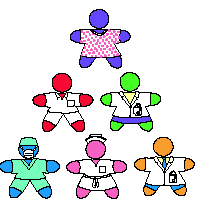BACKGROUND:
The organs of your body are composed of tissues that
are composed of many cells. Cells can be specialized to perform a
particular function such as contraction (muscle) or sensation (nervous).
Nerve cells or neurons conduct nerve impulses to and from the body of the
cell. They transmit impulses all around your body. Touching
something hot causes impulses to move through the neurons and relay the
message to the brain. It is like a train track of nerve cells that
brings the message to your brain. Nerve cells are very delicate and cannot
be regenerated.
The nervous system controls all other functions in
the body. It accomplishes this by two mechanisms which we will group
into voluntary actions and involuntary actions. The nervous system
simulates movement, digestion, circulation, and the direction of all other
body parts.
The somatic nerves control the voluntary cells which
are under conscious control. If you want to raise your hand, and
do so, this is a voluntary motion. The autonomic nerves control the
involuntary motions of your body. These nerves keep check of your
body continuously by maintaining temperature, composition of blood, heart
beat, digestion, and excretion. These are activities that you do
not even think about. Even stress when your blood pressure, pulse
rate, and blood sugar become elevated, is controlled by the autonomic nerves.
The somatic and autonomic systems work together. Skin exposed to
cold air becomes "blue," this is autonomic. At the same time impulses
are sent to the brain for sensations of cold, this is somatic.
PROCEDURE:
- This lab is to get students to realize
that their nervous systems are very complicated. Use large white
shirts as doctor uniforms. Select students that will be the doctor,
and who will administer the activity. Put the suit on the students
and give that student a piece of ice. If you have enough parent volunteers,
you may want a parent to take the role of the doctor.
- Break the class into groups or patients in front of
each doctor. The doctor will put the ice cube on several areas of
the patient's body. The purpose of this is so students can find where
the ice feels the "coldest." The doctor should place the ice on the back
arm, forearm, palm, hand, and fingertips. The patients are supposed
to figure out where the ice feels coldest on their bodies. They should
all feel that the fingertips sense the cold with the greatest sensitivity.
- You may want the doctors to also use the "needle" to
find the most sensitive part of the arm or leg. However, you must
select those students who will not try to really "stick" it to their fellow
students. The needle can be the back of a pen or tongue
depressor. This part should be done with adult supervision.
- Another activity that illustrates the fact that nerves
control motion is for students to find their knee reflex. A
reflex is an action in response to a stimulus, occurring without conscious
effort or thought. Have the patient cross his
 knee and the doctor
uses the reflex hammer to find the spot where the knee will jerk.
This will need supervision, because finding that spot takes a little skill. knee and the doctor
uses the reflex hammer to find the spot where the knee will jerk.
This will need supervision, because finding that spot takes a little skill.
- The doctor can also perform an examination of the eyes to see
if the nerves of the eye react to light. Have one student shine a
small flashlight into another student's eye to observe what the pupil
of the eye will do. It will move, which is an autonomic response
to the light. Only do this lab if an adult guides the students.
You may want to see if any of your studentís parents are doctors
or nurses. They may be able to add to the realism in the classroom.
This lab is for students to realize that their bodies move in very planned
motions. There are motions that we don't have to think about such
as involuntary motions, and there are some that we control such as, voluntary
motions. The nervous system controls this movement. The parts
of our bodies are somehow connected and work in unison, for if they did
not, they would not work.
|